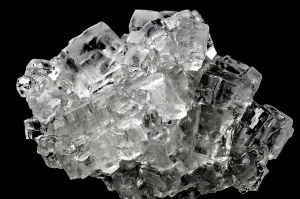Jan 31 2018
From Mother Nature to the essential devices, human beings are surrounded by crystals. That courtesy of the former, such as snow and ice, can form symmetrically and spontaneously. However, the gallium nitride or silicon-based crystals discovered in LEDs and various other electronics need a bit of coaxing in order to obtain their perfect alignments and shapes.
 A cubic salt crystal aggregate. (Image credit: UC Santa Barbara)
A cubic salt crystal aggregate. (Image credit: UC Santa Barbara)
Researchers, at UC Santa Barbara, have presently unlocked another piece of the theoretical puzzle by examining the growth of crystals - a development that could save energy and time in the many processes requiring crystal formation.
The way most industrial processes are designed today is by doing an exhaustively large number of experiments to find out how crystals grow and at what rate they grow under different conditions.
Michael Doherty, UCSB Chemical Engineer
Snowflakes, for example, develop differently as they fall, based on variable conditions such as humidity and temperature; hence the extensively held belief that no two are alike. After establishing the optimal conditions for the growth of the preferred crystal, Doherty added, equipment will have to be designed and calibrated in order provide a constantly growing environment.
However, by pooling decades of expertise, Doherty, together with UCSB colleague Baron Peters and former graduate student Mark Joswiak (presently at Dow Chemical) have succeeded in developing a computational method to enable predicting growth rates for ionic crystals under varied circumstances. With the help of a relatively simple crystal - sodium chloride (NaCl, more commonly known as table salt) - in water, the researchers set out the groundwork for the analysis of more complicated crystals.
Ionic crystals could appear to the naked eye to comprise of perfectly even and smooth faces. However, when observed more closely one can frequently find that they contain surface features capable of influencing their potential to grow, and the bigger shapes that they take.
There are dislocations and around the dislocations there are spirals, and around the spirals there are edges, and around the edges there are kinks and every level requires a theory to describe the number of those features and the rates at which they change.
Baron Peters, UCSB
At the smallest scale, ions in solution will not be able to readily get attached to the growing crystal since water molecules that solvate or interact with the ions, are not readily dislodged, Baron stated. With so many processes taking place at so many scales, it is easy to understand how difficult it can be for predicting a crystal’s growth.
The largest challenge was applying the various techniques and methods to a new problem - examining ion attachment and detachment at surface kink sites, where there is a lack of symmetry coupled with strong ion-water interactions. However, as we encountered problems and found solutions, we gained additional insight on the processes, the role of water molecules and differences between sodium and chloride ions.
Mark Joswiak, Dow Chemical
Among their insights: Ion size matters. The researchers discovered that because of its size, the larger chloride ion (Cl-) stops water from getting into kink sites during detachment, thus restricting the complete rate of sodium chloride dissolution in water.
“You have to find a special coordinate system that can reveal those special solvent rearrangements that create an opening for the ion to slip through the solvent cage and lock onto the kink site,” Peters said. “We demonstrated that at least for sodium chloride we can finally give a concrete answer.”
This proof-of-concept development is the outcome of the Doherty Group’s expertise with crystallization processes along with the Peters Group’s expertise in “rare events” - reasonably infrequent and short-lived but greatly vital phenomena (such as reactions) that basically change the state of the system. Employing a method known as transition path sampling, the researchers succeeded in understanding the events that reach the transition state. The mechanistic insights and strategy from the work on sodium chloride offers a blueprint for predicting growth rates in materials synthesis, biomineralization and pharmaceuticals.